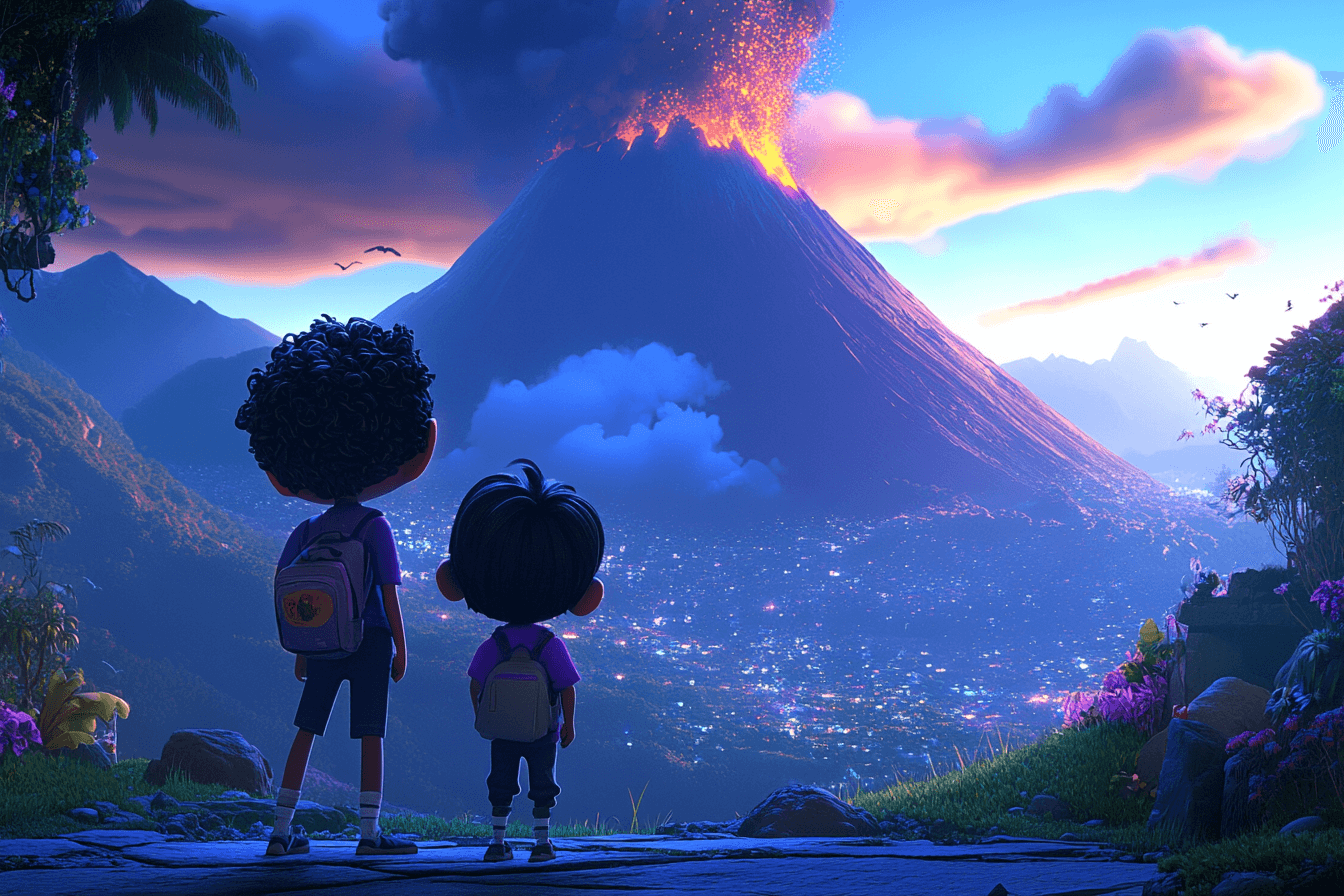What you’ll learn
• Volcanoes act like windows to Earth’s fiery core, where temperatures reach over 2,000°F.
• They form when molten rock called magma pushes through cracks in Earth’s surface.
• When volcanoes erupt, they release lava, ash, and gases that can change landscapes and even affect climate.
• There are three main types of volcanoes: shield, composite (stratovolcanoes), and cinder cone.
• Volcanoes aren’t just destructive—they create new land and eventually support unique ecosystems.
Understanding Volcanoes: A Basic Overview
Volcanoes have long captured the fascination and fear of humanity due to their powerful and unpredictable nature. These geological features serve as windows into the Earth’s fiery core, providing a glimpse of the immense forces at work beneath the planet’s surface.
What is a Volcano?
A volcano is a complex and dynamic structure that serves as a direct connection to the molten rock reservoirs deep within the Earth. The word “volcano” originates from Vulcan, the Roman god of fire, reflecting the intense heat and energy that these natural wonders unleash during eruptions. The process begins with the accumulation of magma, a mixture of molten rock, crystals, and gases, beneath the Earth’s crust. As pressure builds within the magma chamber, it seeks a path of least resistance to the surface, leading to the formation of a volcanic vent.
When a volcano erupts, it releases a combination of molten lava, ash, and gases into the surrounding environment. The lava, which can reach temperatures of over 1,000 degrees Celsius, flows down the volcano’s slopes, creating mesmerizing rivers of molten rock. Ash clouds billow into the sky, carrying fine particles of pulverized rock and glass that can travel vast distances depending on the strength of the eruption. Find out how to make your own volcano here.
Different Types of Volcanoes
Volcanoes come in different shapes and sizes:
Shield Volcanoes: These have gentle, sloping sides formed by easily flowing lava. Mauna Loa in Hawaii is a perfect example. These giants spread out over large areas and generally have less explosive eruptions.
Composite Volcanoes (Stratovolcanoes): These are the tall, cone-shaped mountains most people think of when imagining volcanoes. Mount Fuji in Japan and Mount St. Helens in the United States are famous examples. They’re formed from layers of lava, ash, and rock fragments and can produce violent eruptions.
Cinder Cone Volcanoes: These smaller cone-shaped volcanoes form from fragments of lava that cool in the air and pile up around the vent. They might be smaller, but they’re still powerful!
Exciting Facts for Kids about Volcanoes
1. The Hottest Volcano on Earth
The world’s hottest volcano, Kilauea, is located in Hawaii. It has been erupting continuously since 1983 and is famous for its glowing lava flows. The lava from Kilauea can reach temperatures of up to 2,120 degrees Fahrenheit!
Kilauea is not only known for its extreme heat but also for its unique volcanic features. The volcano is home to a fascinating phenomenon known as a lava lake, where a pool of molten lava sits within the crater. Visitors to the volcano can witness the mesmerizing sight of the lava lake bubbling and spattering, creating a dynamic and ever-changing landscape.
2. The Tallest Volcano: Mauna Kea
Mauna Kea, located in Hawaii, is the tallest volcano on Earth when measured from its base on the ocean floor. It stands at an impressive height of 13,796 feet (4,205 meters) above sea level. Despite its towering height, Mauna Kea is renowned not only for its geological significance but also for its cultural importance to the native Hawaiian people. The volcano is considered a sacred site and is home to numerous archaeological sites and cultural landmarks. Visitors to Mauna Kea can explore the rich history and traditions associated with this majestic volcano, gaining a deeper understanding of its significance beyond its impressive stature.
3. The Shortest Volcano: Paricutin
In contrast, the shortest volcano, Paricutin, located in Mexico, erupted suddenly in 1943. It grew from a fissure in a farmer’s field to a height of 1,345 feet (410 meters) in just one year. Despite its modest height compared to other volcanoes, Paricutin’s rapid formation makes it a fascinating example of the dynamic and unpredictable nature of volcanic activity.
4. Volcanoes on Other Planets
Did you know that volcanoes are not exclusive to Earth? They can also be found on other planets and moons in our solar system. For example, Mars is home to Olympus Mons, the largest volcano in the solar system. It is about 13.6 miles (22 kilometers) high and has a diameter of about 370 miles (600 kilometers)!
Volcanoes on other planets provide valuable insights into the geological processes that shape celestial bodies beyond our own. The presence of volcanoes on Mars, for instance, suggests that the planet was once geologically active, with a potentially different internal structure compared to Earth. Studying these extraterrestrial volcanoes helps scientists better understand the diverse planetary systems in our universe.
5. The Role of Volcanoes in Creating New Land
Volcanoes are not just destructive forces; they also play a crucial role in shaping the Earth’s surface. When volcanoes erupt, they release molten lava that cools and solidifies, forming new land. Over time, this process can create islands, mountains, and even entire continents!
The formation of new land through volcanic activity is a dynamic and ongoing process that significantly impacts the Earth’s geography. For example, the Hawaiian Islands were formed by a volcanic hotspot that created a chain of islands as the Pacific tectonic plate moved over it. This continuous creation of land through volcanic eruptions highlights the ever-changing nature of our planet’s surface and the powerful forces at work beneath the Earth’s crust.
6. Volcanoes and Climate Change
Volcanic eruptions can have a significant impact on the Earth’s climate. When volcanoes release large amounts of ash and gases into the atmosphere, they can block sunlight and cause a temporary cooling effect on the Earth. However, some volcanic gases, such as carbon dioxide, can contribute to global warming if released in large quantities.
Furthermore, volcanic eruptions can also lead to the formation of sulfuric acid aerosols in the stratosphere. These aerosols can reflect sunlight back into space, further contributing to cooling the Earth’s surface. The complex interplay of these different factors highlights the intricate relationship between volcanic activity and climate change.
7. Pioneer Species in Volcanic Environments
Despite the harsh conditions near volcanoes, some plants and animals thrive in these environments. Known as pioneer species, these resilient organisms are the first to colonize the barren volcanic terrain. Over time, they help create a fertile ecosystem that supports a diverse range of wildlife.
8. Wildlife Adaptations in Volcanic Regions
In addition to pioneer species, certain wildlife species have adapted to thrive in volcanic regions. For example, the Galapagos penguin, the only penguin species found north of the equator, has established colonies on the volcanic islands of the Galapagos archipelago. These penguins have adapted to the warm climate of the islands by foraging for food in the cool waters surrounding the volcanic shores, showcasing the remarkable resilience of wildlife in the face of volcanic activity.
9. Environmental Impact of Volcanic Eruptions
Volcanic eruptions not only pose a threat to human life and property but also have a significant impact on the environment. The release of ash, gases, and lava can alter landscapes, disrupt ecosystems, and affect air quality. Volcanic ash, in particular, can have long-lasting effects on agriculture by damaging crops and contaminating water sources. Studying the environmental impact of volcanic eruptions is crucial for understanding how these events shape the world around us and how we can mitigate their effects.
10. What to Do During a Volcanic Eruption
If you find yourself in the vicinity of a volcanic eruption, take immediate action to prioritize your safety. Stay away from the volcano and any areas prone to ashfall, as volcanic ash can be harmful to your health. Seek shelter in a building or a car with closed windows and doors. If you encounter a volcanic mudflow or pyroclastic flow, move to higher ground as quickly as possible. Follow the instructions of local authorities and stay updated with the latest information.
Living Near a Volcano: Safety Tips
For families living near volcanoes:
- • Keep N95 masks available to protect against breathing ash particles.
- • Stay informed about volcanic activity through local authorities.
- • Create an emergency plan with evacuation routes and meeting points.
- • Prepare an emergency kit with food, water, and first aid supplies.
- • Consider installing ash barriers and reinforcing your roof to handle ashfall.
Protecting Your Home and Property
Living near a volcano comes with unique challenges, especially when it comes to protecting your home and property. Consider installing ash barriers or screens to prevent volcanic ash from entering your living spaces. Reinforce your roof to withstand the weight of ashfall, which can accumulate quickly and cause structural damage. It’s also advisable to have a supply of N95 masks to protect yourself and your family from inhaling harmful volcanic ash particles.
In Summary
Volcanoes are powerful forces of nature that both destroy and create. These fascinating formations give us a glimpse into Earth’s fiery interior while shaping our landscapes in dramatic ways. From the towering heights of Mauna Kea to the rapid birth of Paricutin, volcanoes continue to captivate our imagination and remind us of our planet’s dynamic nature.

Want a fun volcano related experiment?
Try creating your own volcano out of household items!
Keep Reading!



